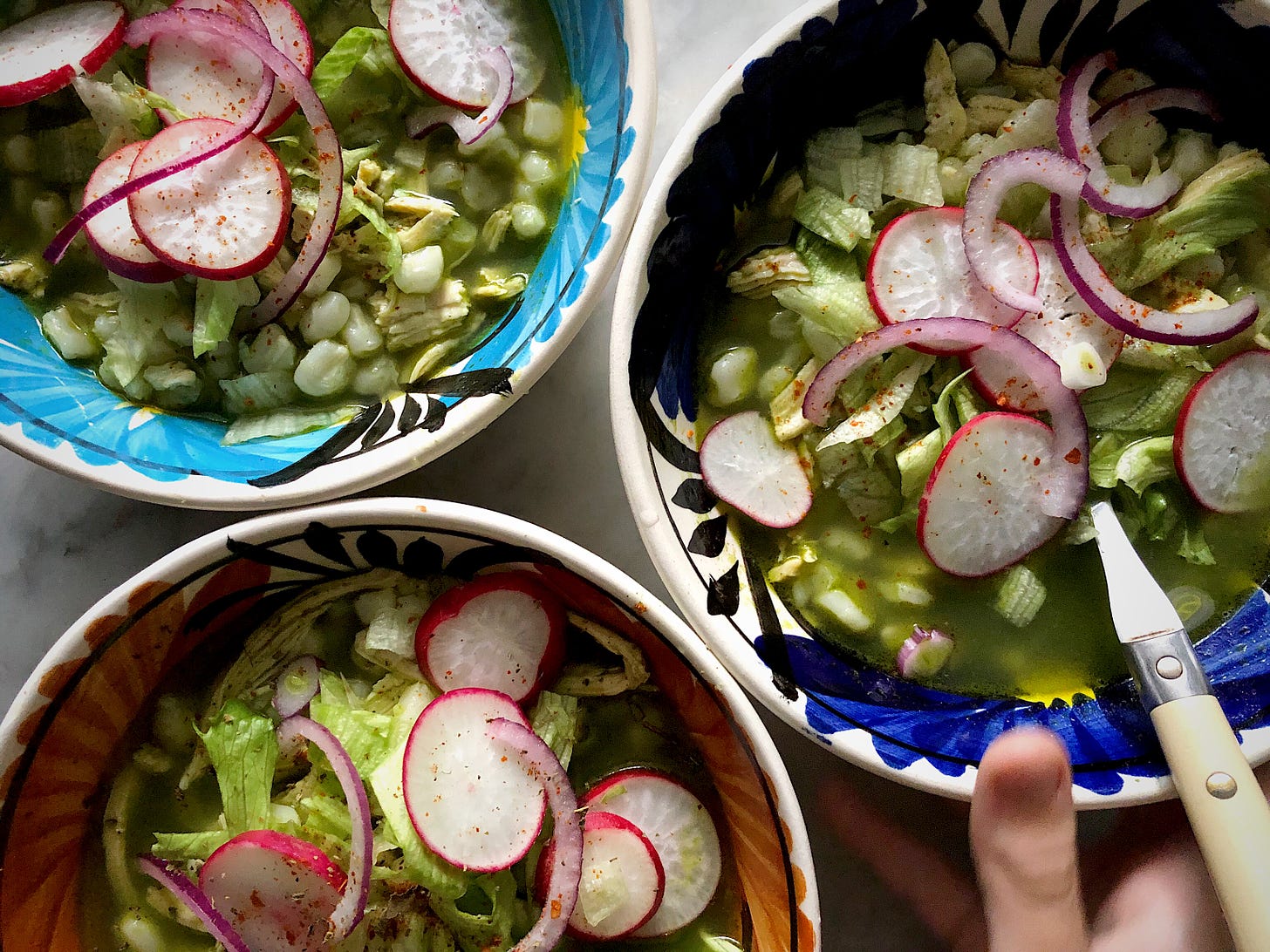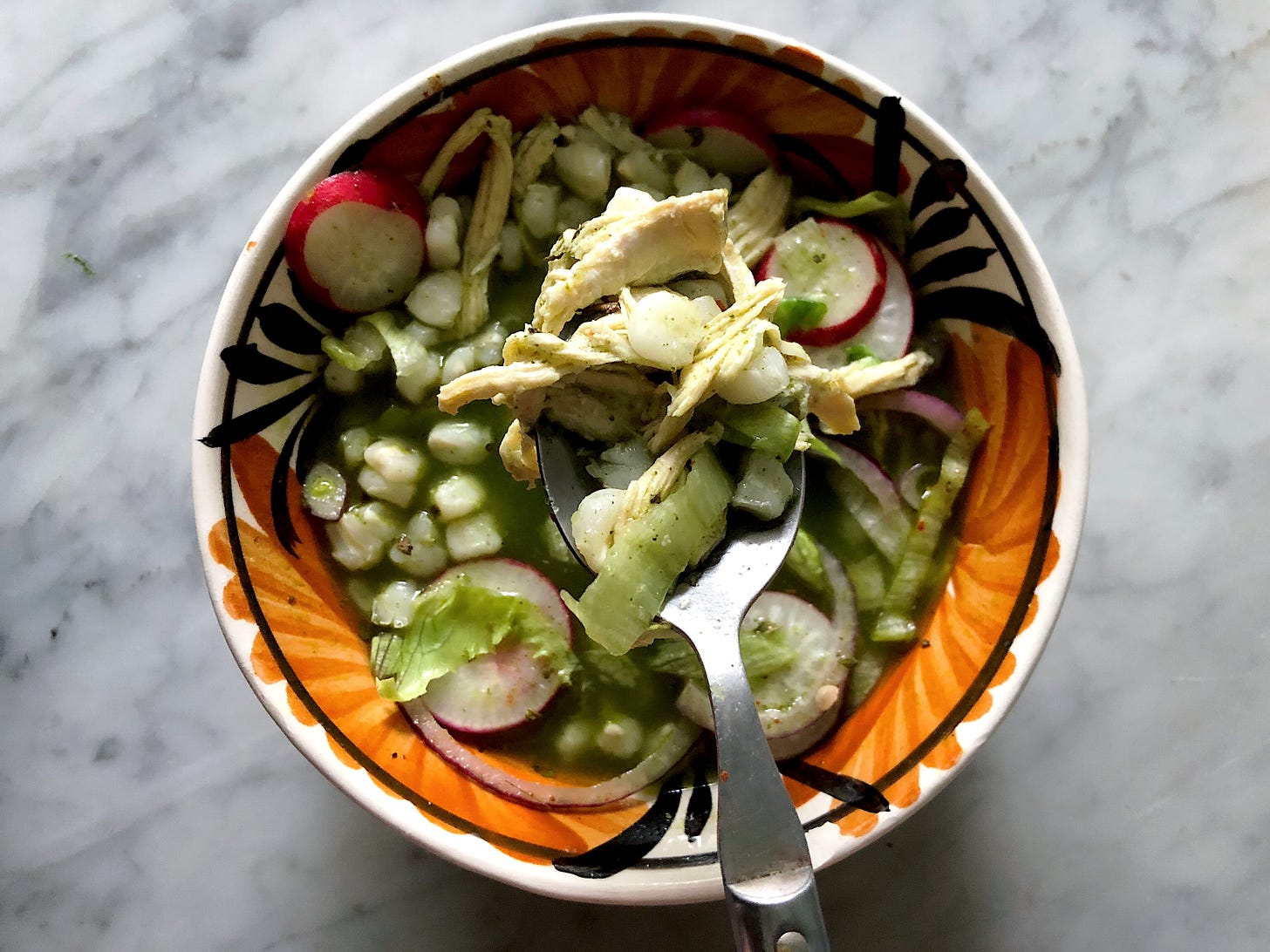FOOD AS AN EXPRESSION OF NATION-NESS: Green Oaxacan Pozole, 'Fake' Chiles en Nogada, and Chiles Rellenos in Yellow Tomatillo Salsa.
Mexican Independence Day Food.
For the last 15 years —give or take—, during the current month of September, which is popularly referred to in Mexico as the “mes patrio” (or “patriotic month”), the presence of chiles en nogada as a commemorative dish, through the media and in restaurants, has become so predominant, so iconically tied to Mexican Independence, that the pozole of my family celebrations now seems like a fading memory, almost like my sense of patriotism these days.
I like chiles en nogada, as long as they do not fall too much on the sweet side like they often do (which is a perfectly understandable tendency, since they were first invented as a dessert[1]), I think it is a brilliant dish, both esthetically and in terms of flavor. But what I find most fascinating about them is the symbolic load that they carry; all of the myths and controversies that circle around them. Chiles en nogada are, literally, and metaphorically, a dish with many layers. People in Mexico tend to either love them, sometimes to the point of engaging in interminable discussions (usually through social media like Twitter, that is where most toxic human interaction unleashes nowdays) to defend their purity (there is an unofficial “chiles en nogada police” that does not tolerate any deviation from the “original” recipe), or hate them, sometimes to the point of engaging in interminable discussions for the only pleasure of pissing-off the chiles en nogada police. It is very debatable though, for this controversially-delicious sweet and savory dish to be considered the quintessential Mexican Independence food, (especially if that means stealing the spotlight from pozole) but it sure is the best possible example of Mexican culinary fakelore[2].
Chiles en nogada were not only absent from my family’s Independence Day gatherings, but they also did not figure in either of my grandmothers’ cookbooks (and they were vast in Mexican recipes). I am probably the first generation of my family to cook them. Big platters with tostadas de pata (brined pork-feet) were placed at our family table every 15th of September eve as an appetizer, surrounded by different-sized dishes with the garnishings for the pozole (dried orégano, diced lettuce, chopped onion, sliced radish, and powdered chili), fresh cream and molcajete salsa roja for the tostadas. And that was it, we stuffed ourselves and then proceeded to the living room to watch the president in turn on tv, shout from the balcony of Palacio Nacional: ¡Vivan los héroes que nos dieron patria y libertad! ¡Víva Hidalgo! ¡Viva Morelos! ¡Viva Josefa Ortiz de Domínguez! ¡Viva Allende! ¡Vivan Aldama y Matamoros! ¡Viva la independencia nacional! ¡Viva México! ¡Viva México! ¡Viva México!
Although chiles en nogada were not present in my culinary family traditions, I do remember eating them when I was younger, but they were more of a restaurant dish, and they were not served in that many places (we used to eat them at Fonda Santa Clara in the historic center of DF). I thought they were gorgeous and delicious but they did seem kind of foreign to me, which they mostly are if we trace back the origins of each of its ingredients. Chiles en nogada may seem very Mexican on the surface, but as I said before, they have many layers, and none of them, not even the one that’s most visible to us (with the exception of the chiles poblanos, which are a hybrid of Spanish peppers and Mexican chiles) are composed of ingredients that are native to Mexico.
According to the recount of anthropologist Eduardo Merlos[3], about the origin of chiles en nogada —or at least, its most spread out version about them being invented by nuns of the Santa Mónica Convent in Puebla to commemorate Agustin de Iturbide’s saint day, as he became the first emperor of independent Mexico—, is actually based on two lies (white lies, in this case, since they were apparently confabulated by the nuns): the first one is that it was not exactly Iturbide’s saint day, but 20 days before that; and the second one, is that they were not invented specially for the new emperor (they only said that to flatter him, those naughty nuns), but had existed for at least a hundred years before that, and were served every 28th of September in honor of their patron, Saint Agustine.
As Merlos explains, until then, chiles en nogada were meant as a dessert dish and didn’t have any meat in them, since they were eaten during a religious holiday. He also points out that their most important characteristic —without which, in his words, they can’t be officially called “chiles en nogada”— is the egg coating, because it emulates the gold coating of the altarpieces that expresses the Baroque nature of the dish (and Hispanics’ obsession with gold, if I may add), and that the only different thing that the nuns did the day the served it to Iturbide, as part of a 14-course meal, was adding the pomegranate and the parsley, that were intended to complete the colors of the Three Guarantee flag that the young monarch had just conceived: white for religion (already present in the Castillian walnut sauce), green for freedom, and red for union. As brilliant and they are, chiles en nogada are not exactly a dish that spontaneously evolved from an authentic sense of Mexicanity, but the result of a constructed national narrative, whose values were still very conservative and predominantly Hispanic.
Pozole, on the other hand, has been eaten in this land for thousands of years. It is commonly mentioned in documents of Indies as a part of religious ceremonies, where it was often said to be served with human meat. That aspect of it, of course, has transformed, but it does maintain a ritualistic quality and its culinary character. In contrast to the unmodifiable nature of chiles en nogada, pozole has changed many times over the course of history and has adapted to different surroundings and circumstances. From colonization, it adopted some of its garnishings and the use of fat, pork, and beef, and it sure benefited from them. There are diverse pozoles all over Mexico; in Guerrero, for example, there’s a different one for each day of the week. There are green, white, and red pozoles; pozoles with chicken, pork, beef, beans, vegetables, herbs, seafood, amphibians, insects, and various kinds of dried-fish. It is a very flexible and inclusive dish, and yet, it never loses its essence.
I love chiles en nogada, but if I were to decide between the two dishes, I would definitely go for pozole, it brings me more comfort. I do think though, that it is somewhere in the border of this apparently divided staple dishes, were a true Mexican nationality lies (if such a thing exists), since food is one thing we can all agree to love about calling ourselves, Mexican. Happy Independence Day!
[1] Link. [2] A term used by historian Andrew Smith (in Walker, 2001) to refer to culinary mythologies. Davidson, Alan. “The Oxford Companion to Food”. iBooks. [3] Link.
TO CLEAN THE CHILES
No matter what kind of filling you are going to use or if the chiles are intended to make rajas, this is the process to clean poblano chiles…
TO COAT THEM
*This process is optional, just remember that if you are not going to use it for chiles en nogada, you just have to name them any other way you like. I am using the same quantities as the recipe below. This step follows the filling of the chiles.
Ingredients:
8 filled poblano chiles.
6 eggs, the whites separated from the yolks.
6 to 8 tablespoons of flour.
Salt to taste.
Around 1 1/2 to 2 cups of vegetable oil.
Preparation:
Beat the eggs until fluffy, and incorporate the yolks.
Put the flour on a an extended dish, salt to taste, and coat the filled chiles.
Heat the oil (regulate the temperature, to medium hot)
Coat the chiles with the egg mix, fry until golden, and drain the excess oil.
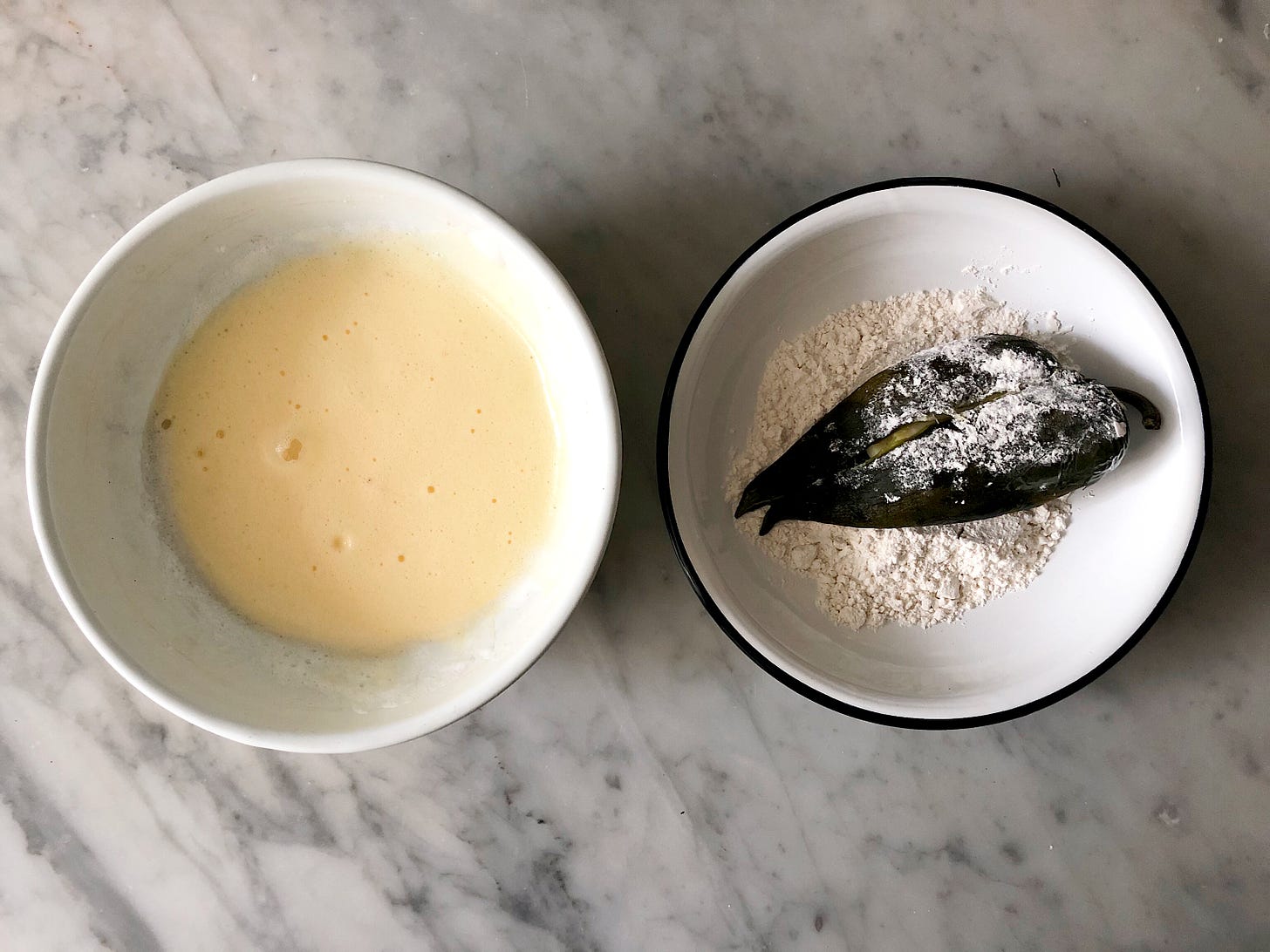
*I didn’t have any skewers, as you can see, but do not panic if it happens to you, just handle the chiles carefully, they will hold together after you fry them in the oil. They don’t have to be perfect so don’t stress yourself, the worst that can happen is that you get excommunicated from the catholic faith.
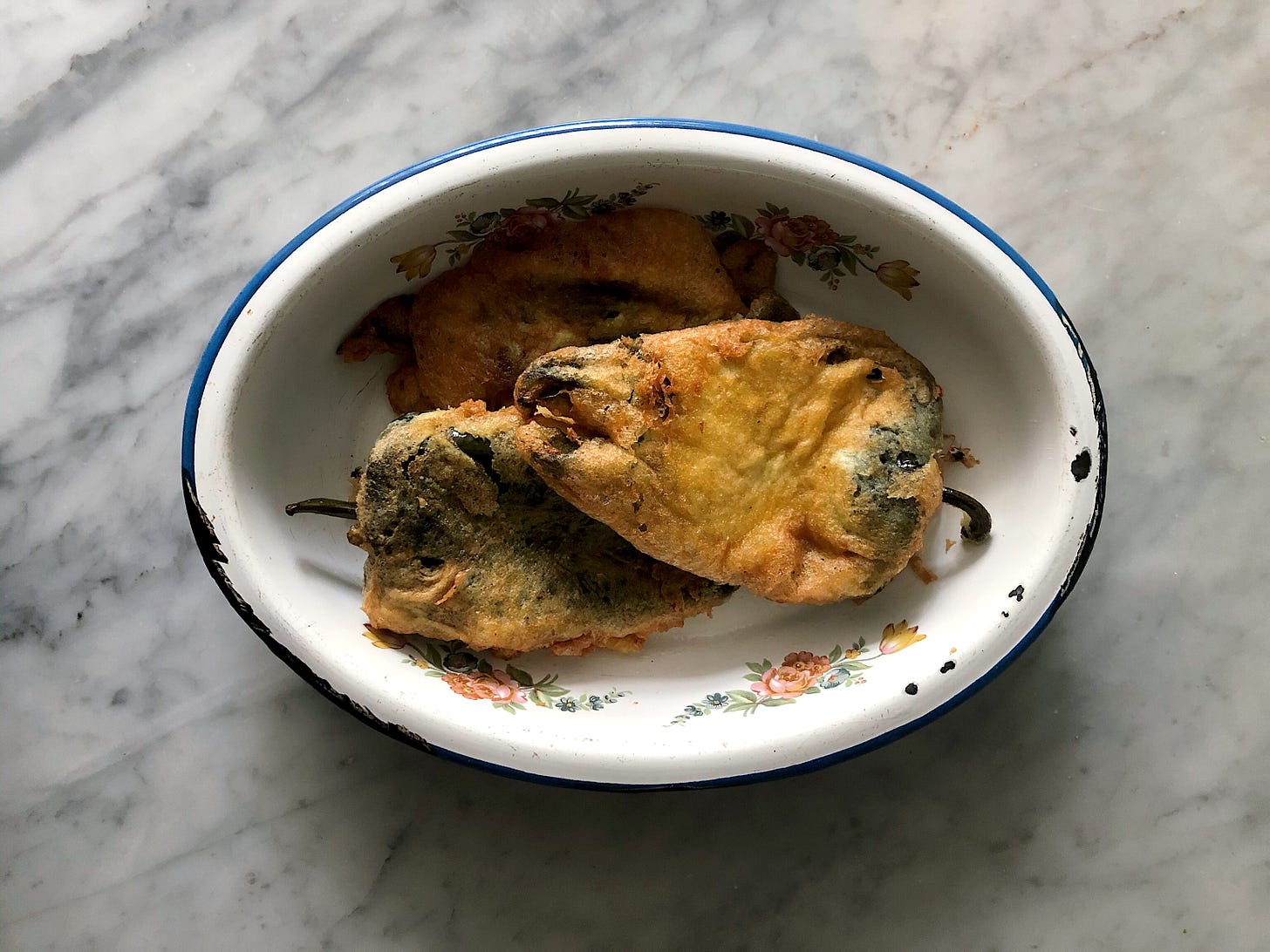
FAKE CHILES EN NOGADA
Serves 4 to 6 people.
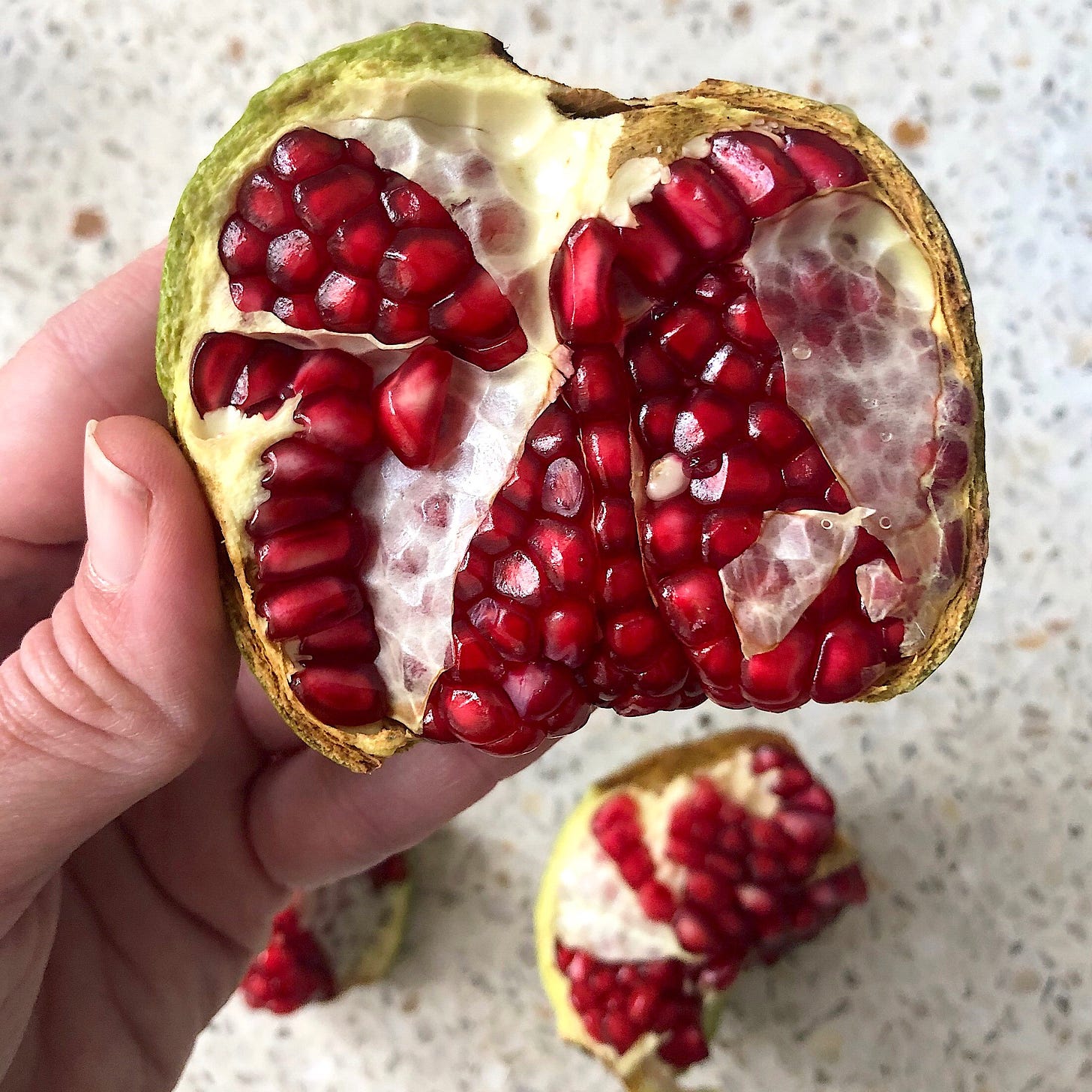
This, as you know, if you read the essay at the beginning of this post, is not an authentic version of chiles en nogada, not only because my recipe is not exactly by the book in terms of ingredients, but most important of all, because as anthropologist Eduardo Merlo points out: “
Ingredients:
8 clean poblano chiles (you can coat them after filling them if you like, and then you’ll be able to officially call them chiles en nogada).
For the toppings: 1-2 cups of shelled pomgranates, a bunch of chopped parsley.
For the filling:
250 g of minced pork.
250 of minced beef.
4 medium cloves of garlic (minced).
1 small chopped onion.
1 semi-ripe plantain.
2 apples.
3 peaches.
2 pears.
1/4 cup of chopped almonds.
1/4 cup of chopped walnuts.
1/4 cup of pine nuts.
1/2 a cup of raisins.
vegetable oil as needed.
Salt to taste.
Preparation:
Heat the oil, add the chopped onion and minced garlic, and sauté until it starts to golden.
Add the fruit and let cook for around 5 minutes add the nuts and raisins.
Take the fruit out, add a bit more oil if needed, and saute the minced pork and beef.
Add salt to taste, mix with the fruit, and let cool.
When the meat is completely cool (remember chiles en nogada are served at room temperature), fill the chiles, and if you need to, you can use some skewers to hold them together (just don’t forget to take them our before serving. It happens…).
Proceed to coat them if you are going to and let cool.
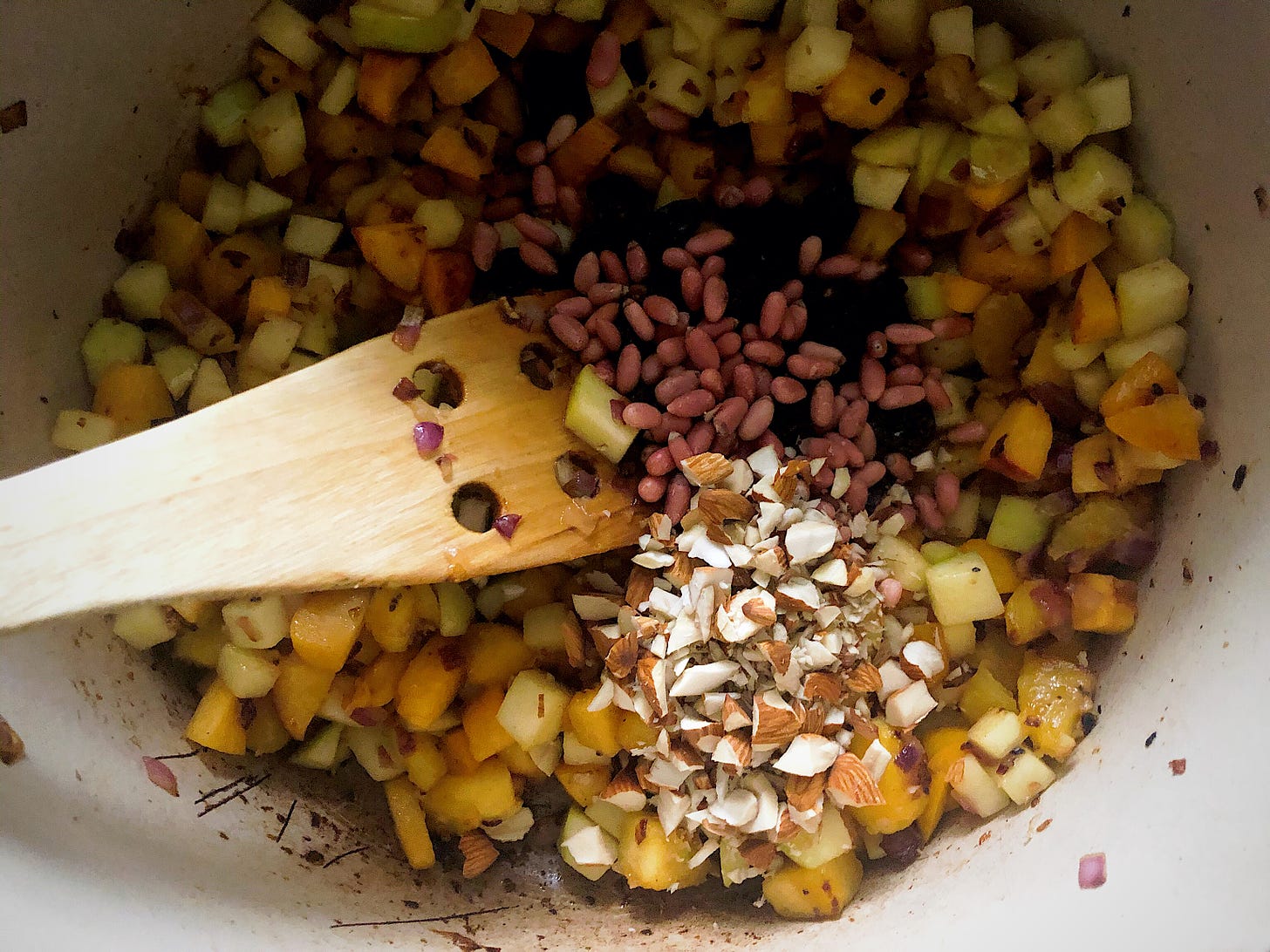
For the nogada:
1 cup of walnuts.
240 g of plain goat cheese.
wine, sherry, or milk as needed until desired consistency.
2 - 3 teaspoons of sugar.
salt to taste.
Preparation:
Blend all of the ingredients together, and add slowly liquid until desired consistency.
Add sugar and salt to taste.
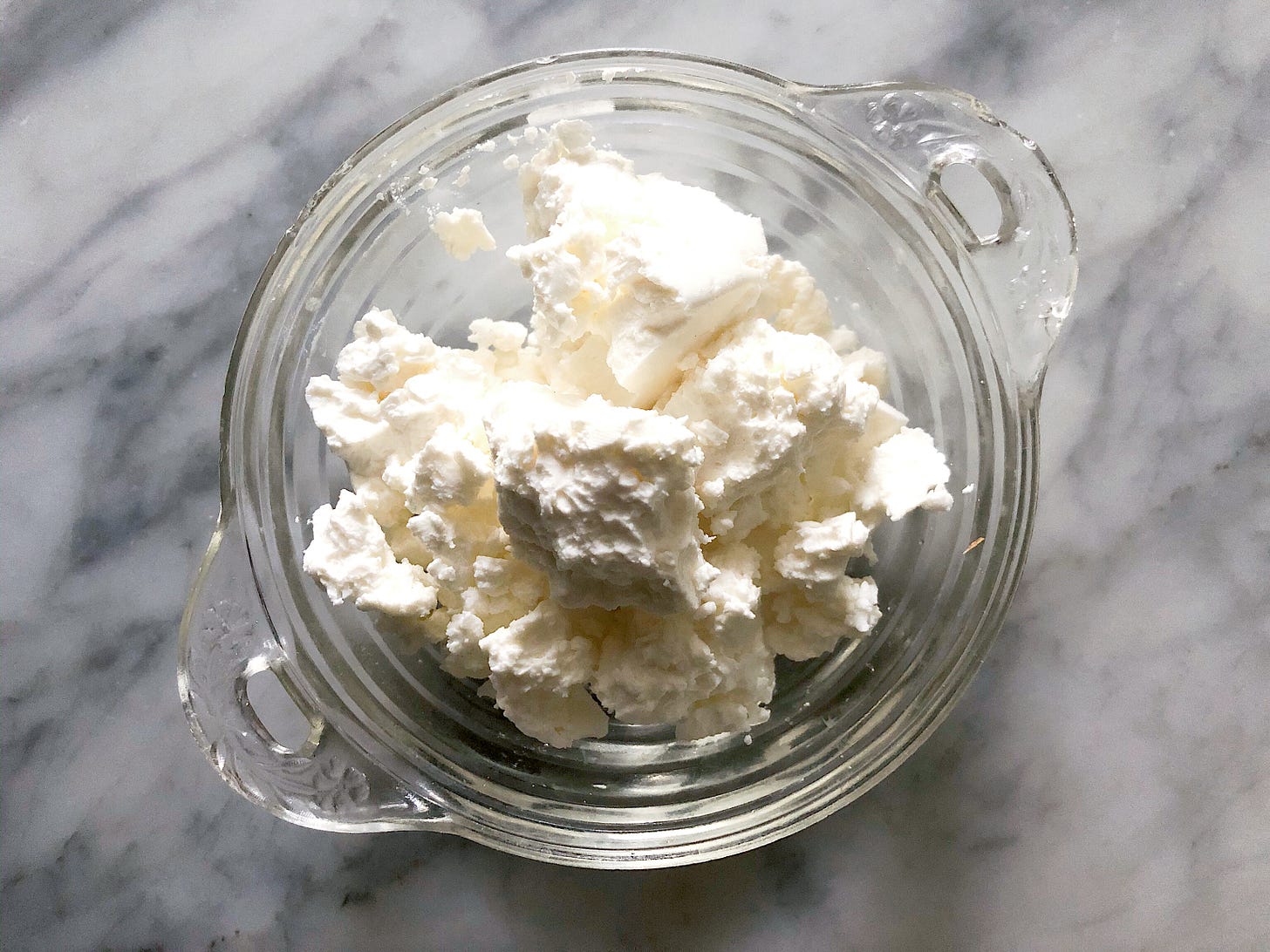
Assemble:
Place the chiles on one big platter or serve individually.
Coat with the nogada.
Top with the pomegranate and parsley.
Serve at room temperature.
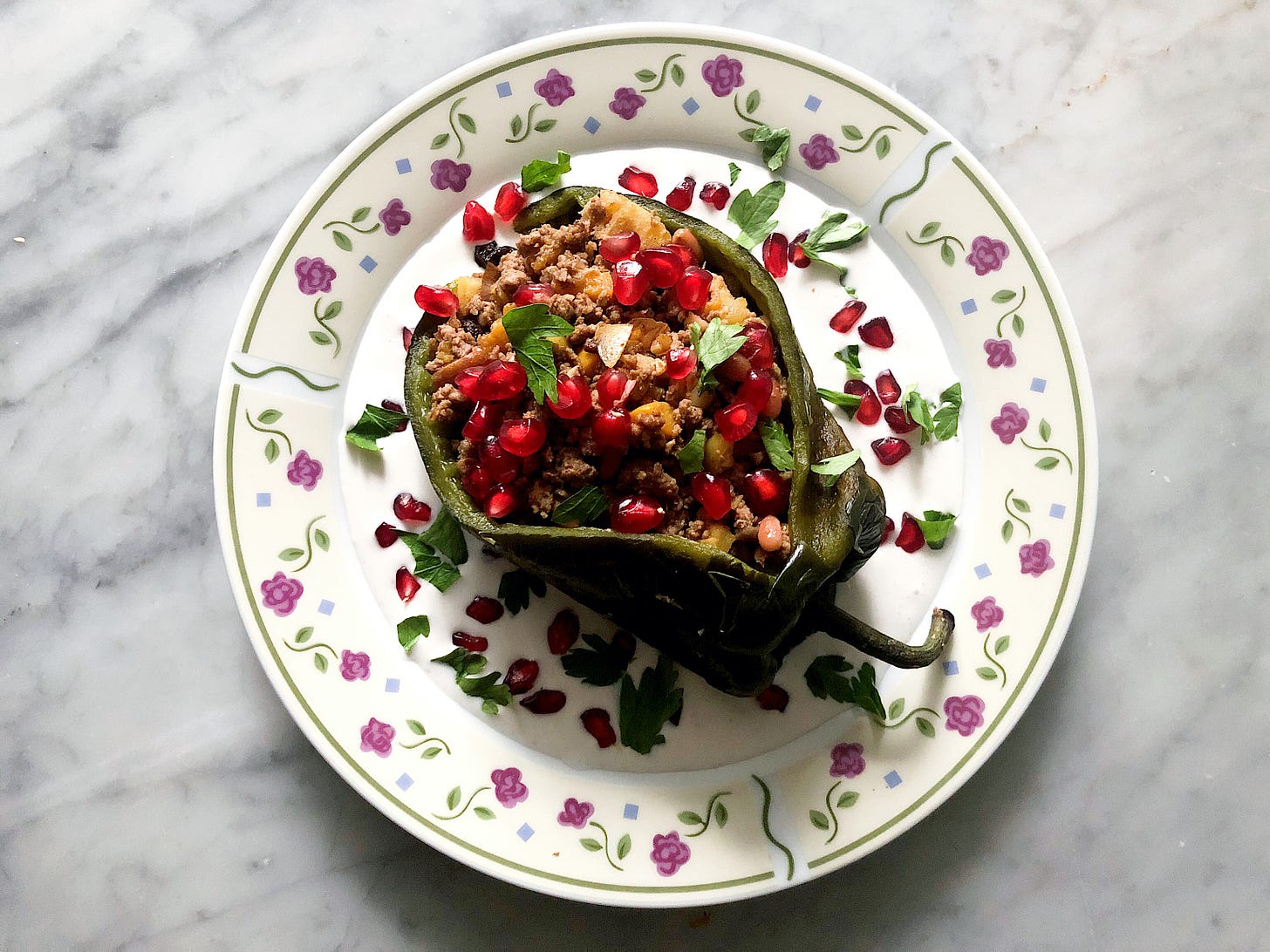
CHILES RELLENOS WITH CHEESE AND YELLOW TOMATILLO SAUCE
Serves 4 to 6 people.
During this season, you can sometimes find yellow tomatillos in some mercados. The difference between green and yellow tomatillos is that they are much sweeter, almost like a fruit, but without losing their characteristic acidity.
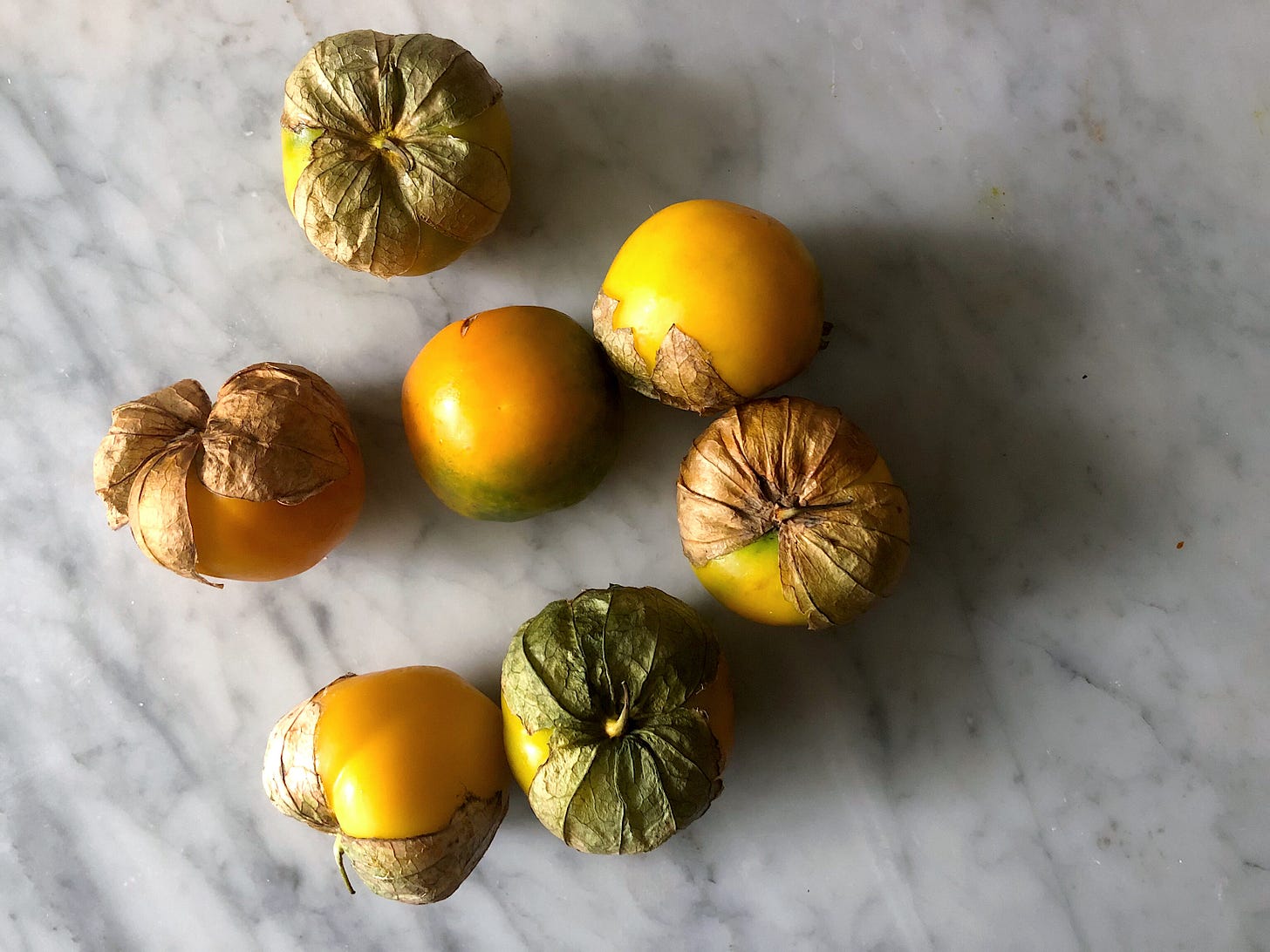
Ingredients:
8 clean poblano chiles, coated or not coated (follow the indications above and fill the chiles with big slices of cheese before coating).
150 g of jack, mozzarella, or any cheese that melts.
1 k of yellow tomatillos or any kind of tomato you like in cubes.
1/2 an onion chopped.
3 medium cloves of garlic (minced).
1 teaspoon of dried oregano.
1/2 a teaspoon of cumin (you can use powdered cumin or ground it in a mortar).
Water if needed.
Vegetable oil.
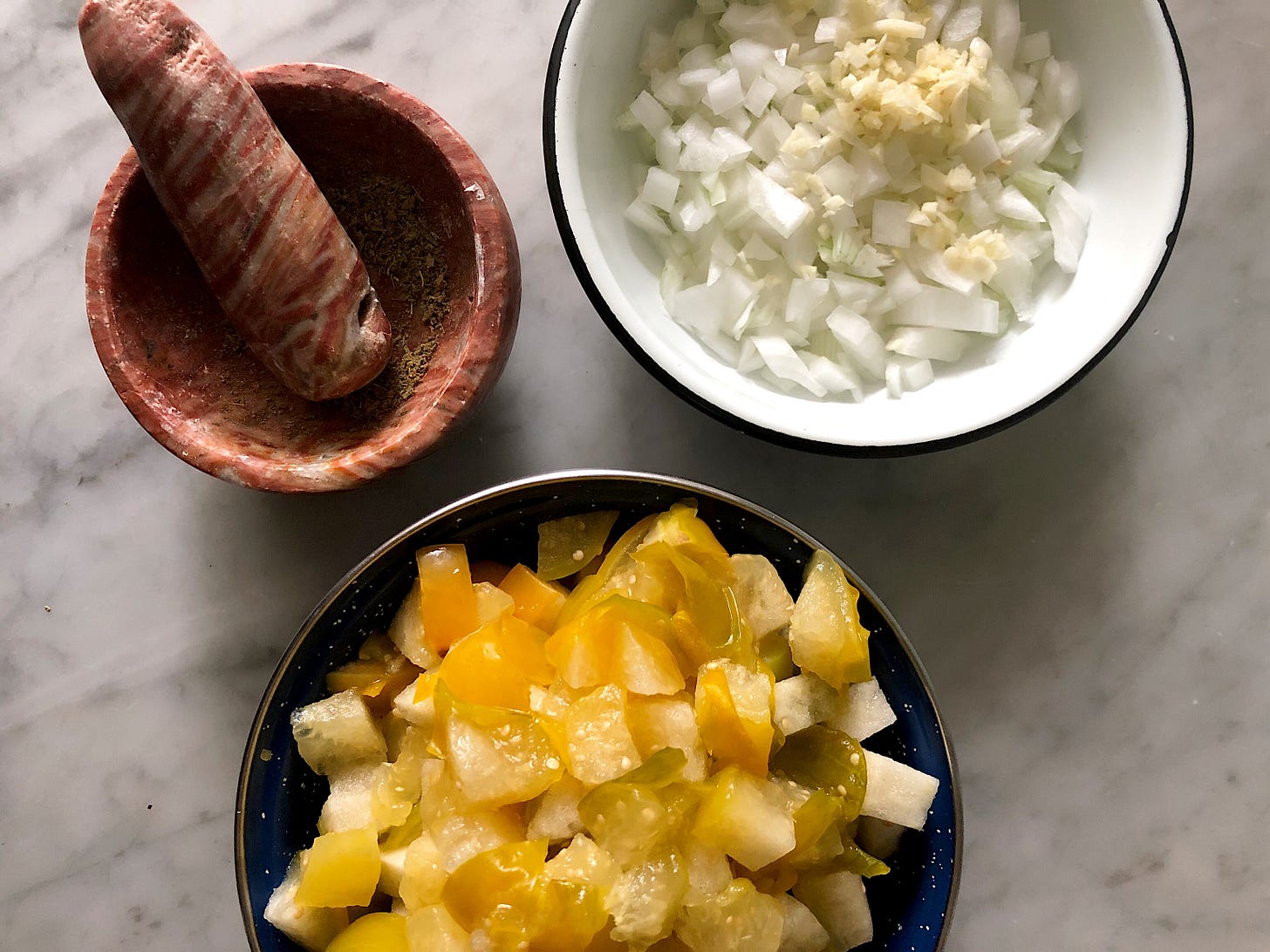
Preparation:
Heat oil in a pan.
Sautée the onions and the garlic with the spices.
Add the cubed tomatillos and let cook for 10 to 15 minutes.
Add water if needed.
Salt to taste.
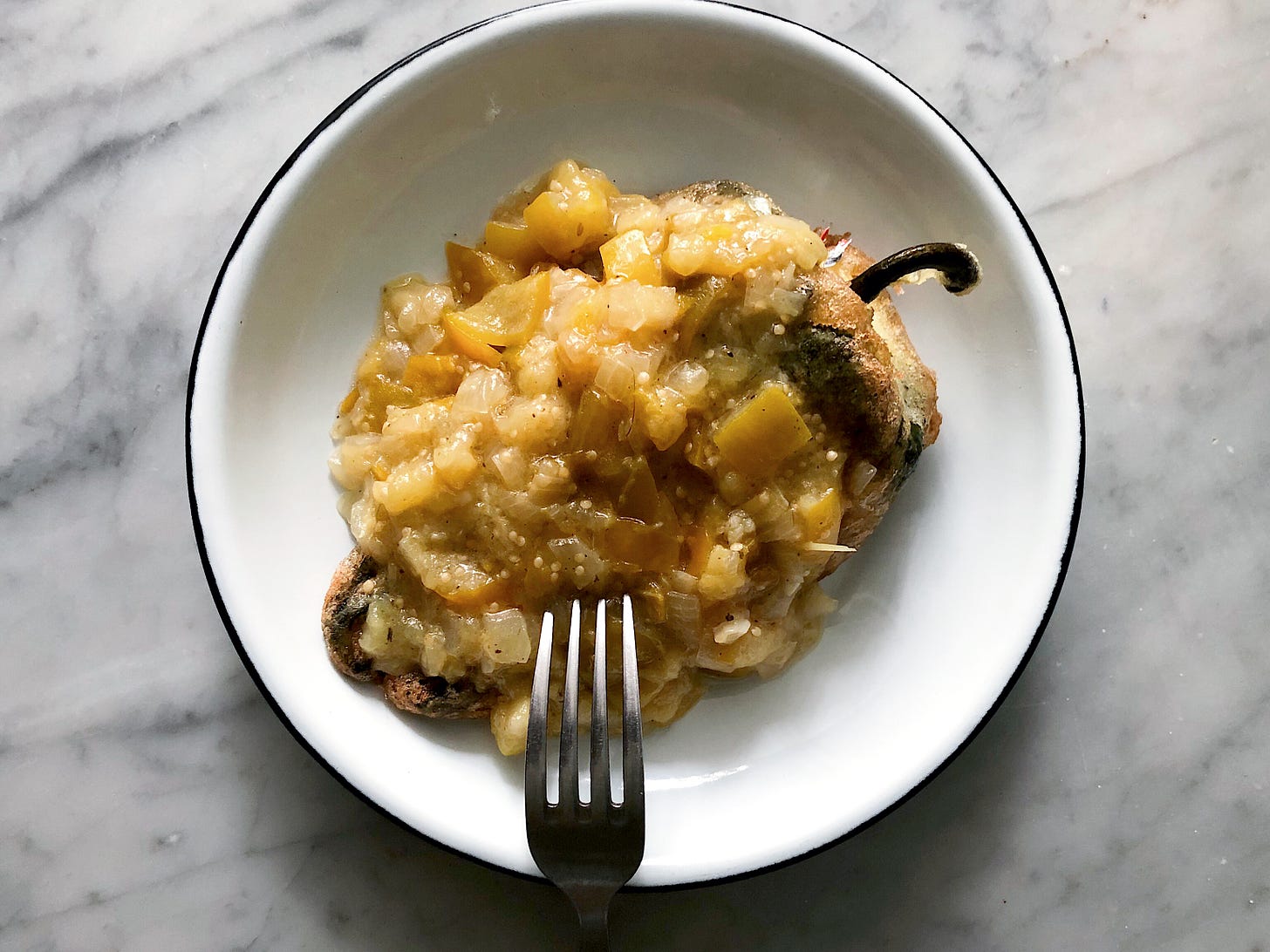
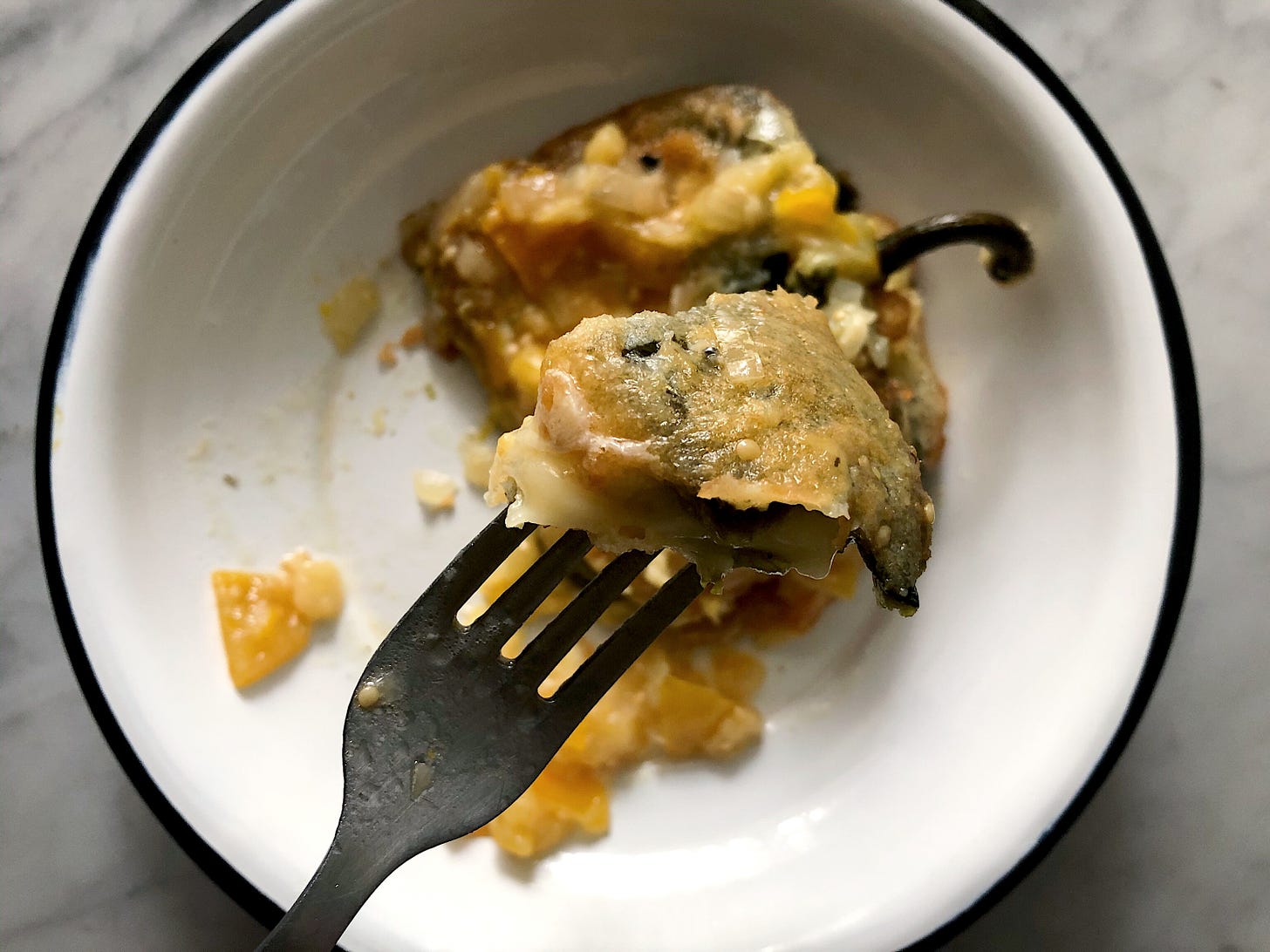
POZOLE VERDE OAXAQUEÑO

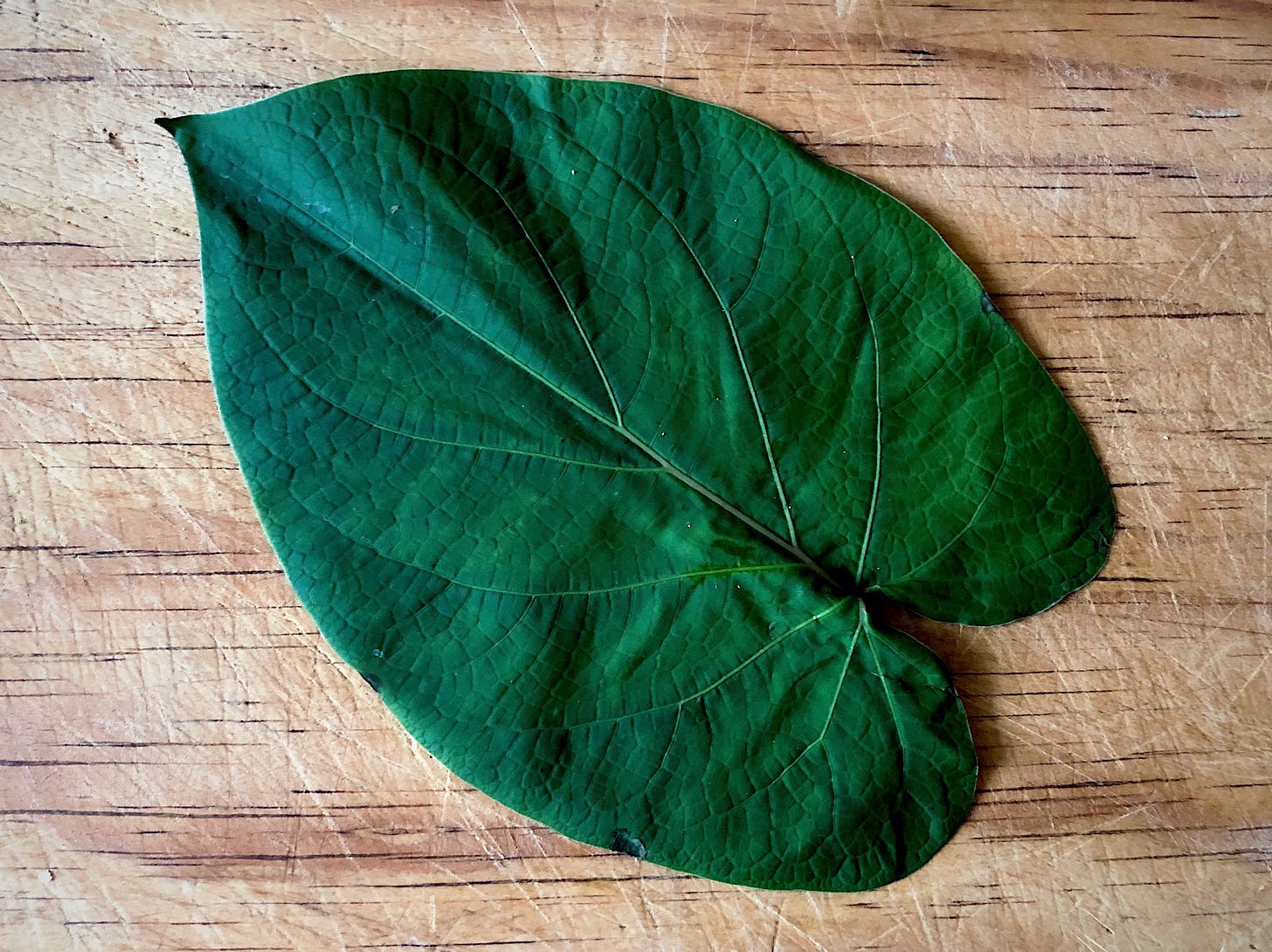
Ingredients:
1 k of white hominy.
1 whole breast of chicken.
2 bay leaves.
2 l of water.
6 leaves of hoja santa (if you can’t find hoja santa you can use your favorite greens. I once used a mix of spinach leaves and a bunch of coriander and it came out very good).
2-4 jalapeño chiles (you can seed the chiles or leave them to make it spicier, the quantity is also your choice).
1/2 an onion.
2 medium pieces of garlic
Extra water if necessary.
Vegetable oil.
Salt to taste.
To serve:
1 cup of sliced radish.
2 cups of shredded lettuce.
1/4 of an onion sliced or chopped.
Chili powder.
Dried oregano.
Lime.
Tostadas. *Optional
Preparation.
Cook the chicken breast with the 2 l of water and the bay leaves.
Take the chicken out when it is ready and let it cool so you can shred it.
Blend the hoja santa with the garlic, onion, and chiles.
Heat the oil, add the hoja santa mix, followed by the chicken broth.
Add the hominy and let cook until soft.
Add more water if needed and salt to taste.
Serve hot with the shredded chicken and the garnishings.
You can accompany with mezcal and listen to some rancheras or your favorite Mexican music to get into the 15th of September mood.
